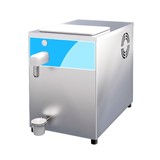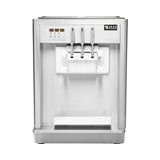Explore cream pasteuriser machine prices and buying tips for Australian dairy producers. Discover types, operational costs, compliance, financing options, and ROI insights to make a confident purchase.
Key takeaways
- Price range: Commercial cream pasteurisers in Australia typically range from $7,000 to $45,000, depending on capacity, automation, and features.
- Machine types: Batch pasteurisers are best for small-scale and artisan producers, while continuous HTST systems suit medium to large operations.
- Capacity options: Machines range from 50L to 1,000L+. Expect to pay $7,000-$12,000 for 50-100L, and $30,000+ for high-capacity or continuous flow systems.
- Maintenance costs: Annual maintenance may cost $800 to $2,000, depending on machine complexity and usage.
- Compliance: Machines must comply with Australian New Zealand Food Standards Code and may require NSW Food Authority or Dairy Food Safety Victoria (DFSV) registration.
- Finance options: Equipment loans, low-doc finance, or lease-to-own available with terms from 2 to 5 years, depending on lender.
Introduction
Cream pasteuriser machines are critical equipment for Australian dairy processors, creameries, and food manufacturers. Whether you're launching a boutique dairy line or scaling a commercial production facility, choosing the right pasteuriser impacts product quality, compliance, and profitability.
This comprehensive buying guide covers everything you need to know before purchasing a cream pasteuriser in Australia, including types, pricing, operational insights, maintenance, certifications, and FAQs. It’s designed to help you make a confident and compliant purchasing decision.
Types of cream pasteuriser machines
1. Batch pasteurisers
Ideal for small-scale producers or artisan dairies.
- Heat cream to pasteurisation temperature (typically 72°C) and hold for a set period.
- Simple operation and lower cost.
- Common capacities: 50L to 300L.
Pros:
- Cost-effective entry point.
- Easy to clean and operate.
Cons:
- Slower processing times.
- Less suitable for high-volume needs.
2. Continuous pasteurisers (HTST - High Temperature Short Time)
Suited for commercial producers requiring higher throughput.
- Heats cream rapidly (typically to 72°C for 15 seconds), then cools instantly.
- Includes regenerative heating for energy efficiency.
Pros:
- High processing speed.
- Better energy efficiency for large volumes.
Cons:
- More expensive upfront.
- Requires higher technical expertise.
3. Vacuum pasteurisers
Used for sensitive dairy products or cream with high fat content.
- Pasteurisation under reduced pressure lowers the boiling point.
- Preserves delicate flavours and textures.
Used primarily for: Premium cream, clotted cream, or value-added dairy products.
Cream pasteuriser machine prices in Australia
Prices vary depending on factors such as capacity, automation level, construction material (e.g. stainless steel vs. hybrid), and features like integrated Clean-in-Place (CIP) systems. Here’s a breakdown of typical pricing by capacity and type:
- 50–100L batch pasteurisers typically cost $7,000 to $12,000, ideal for small-scale or start-up operations.
- 200–300L batch pasteurisers are priced between $12,000 and $20,000, suitable for mid-sized artisan or specialty producers.
- 300–500L HTST (continuous) systems generally fall in the $25,000 to $35,000 range, offering higher throughput for growing businesses.
- 500L+ HTST automated systems start from around $35,000, with advanced models reaching $45,000 or more, ideal for large-scale commercial operations requiring consistent, high-capacity output.
Always ensure to account for additional costs such as freight, installation, and training, which may or may not be included in the base price.
Tip: Always confirm delivery, installation, and training are included in final pricing.
How cream pasteurisers operate
- Filling: Cream is pumped into the vessel.
- Heating: Machine heats cream to required temperature (typically 72°C).
- Holding: Temperature is maintained for required time (e.g., 15 seconds to 30 minutes depending on method).
- Cooling: Rapid cooling to 4°C to prevent bacterial regrowth.
- Discharge: Pasteurised cream is pumped out for packaging or further processing.
Key features to consider:
- Digital temperature controls
- Agitator/mixer for uniform heating
- Double-jacketed vessels for indirect heating
- Automatic or manual valves
- CIP compatibility for cleaning efficiency
Maintenance and servicing
Proper maintenance ensures longevity and compliance.
Routine maintenance tasks:
- Daily cleaning of vessel, valves, and pipes
- Weekly inspection of gaskets and seals
- Monthly calibration of temperature sensors
Annual service costs:
- Batch pasteurisers: $800 - $1,200/year
- Continuous systems: $1,500 - $2,000/year
Tip: Choose machines with Australian-based support or local spare part availability.
Common replacement parts
- Seals and gaskets: Prone to wear from heat/chemical exposure.
- Sensors and thermostats: Essential for accurate temperature control.
- Agitator motors and belts: Subject to mechanical wear.
- Heating elements or steam injectors: May need replacing after 3-5 years.
Always keep a spare parts list from the manufacturer to avoid production delays.
Financing cream pasteuriser machines in Australia
Australian buyers have multiple finance options for acquiring cream pasteurisers.
1. Equipment loans
- Ownership at end of term.
- Rates from 7% - 12% p.a. depending on credit.
- Terms from 2 to 5 years.
2. Lease-to-own
- No upfront payment.
- Tax-deductible lease payments.
- Buyout option at end.
3. Low-doc equipment finance
- Ideal for new or small businesses.
- Requires minimal paperwork (ABN, GST, bank statements).
Financing tips:
- Compare lenders who specialise in food equipment or dairy machinery.
- Ask if finance includes installation and training.
Warranty and after-sales support
Warranties vary by manufacturer and type:
- Batch pasteurisers: Typically 12-24 months.
- HTST systems: 18-36 months.
Inclusions to confirm:
- Parts and labour coverage
- On-site repairs or replacement policy
- Remote diagnostics or support access
Extended warranties are often available for an added fee.
Operational costs and ROI considerations
While the upfront cost of a cream pasteuriser machine is a significant investment, understanding the ongoing operational costs and potential return on investment (ROI) is just as important when making a purchasing decision.
Electricity consumption
Cream pasteurisers require consistent heating and cooling, which can be energy-intensive. On average:
- Small batch units (50–100L) consume around 3–5 kWh per hour.
- Medium units (200–300L) may draw 5–8 kWh per hour.
- HTST continuous systems (300L+) can use 8–12+ kWh per hour, depending on automation and recovery systems.
Installing models with regenerative heating or heat exchangers can reduce energy use by up to 30%, which significantly lowers long-term operating costs.
Labour requirements
Manual batch pasteurisers often require a dedicated operator to manage filling, temperature control, agitation, and discharge. For small businesses, this may mean one staff member per 100L unit during processing hours. In contrast, automated HTST systems can be operated with minimal supervision, freeing up labour for other production tasks.
Cleaning time and downtime
Machines without Clean-in-Place (CIP) functionality require manual disassembly and sanitisation, which can take 30–60 minutes per cycle. CIP-equipped units reduce this to 15–30 minutes, improving hygiene and production uptime. Over a week or month, this time saving adds measurable operational efficiency.
Return on investment (ROI)
For most small-to-medium Australian dairy producers, the ROI period on a new pasteuriser is typically 12 to 24 months. Key ROI drivers include:
- Increased production capacity, allowing for larger or more frequent batches.
- Improved product shelf life, enabling wider distribution and less waste.
- In-house pasteurisation replacing outsourced processing (e.g. co-packing), saving an average of $1,500–$3,000 per month.
- Product expansion, such as launching new lines (e.g. crème fraîche, flavoured creams) to grow revenue.
Tip: Monitor your cream output, energy costs, and labour input monthly post-installation to track actual ROI. Many suppliers can also provide pre-purchase ROI modelling to help validate your investment.
Compliance and certification in Australia
Pasteurisers must be compliant with AS/NZS 60335.1:2020 for electrical safety, and pressure components must meet AS 1210:2010 Pressure Vessels, ensuring they are legally operable within Australian food manufacturing environments.
Pasteurisers used in food production must comply with:
1. Food Standards Australia New Zealand (FSANZ)
- Must meet Standard 4.2.4 (Primary Production and Processing Standard for Dairy Products).
- Pasteurisation must achieve 5-log reduction in pathogenic organisms.
2. State-based dairy regulators
- NSW: Requires registration with NSW Food Authority.
- VIC: Compliance with Dairy Food Safety Victoria (DFSV).
- QLD, SA, WA: Respective state departments regulate dairy equipment.
3. Electrical and pressure compliance
- Must be certified to AS/NZS 60335 for electrical safety.
- Pressure vessels must comply with AS 1210.
Tip: Request compliance documentation before purchase.
Frequently asked questions
Q1. Do I need a pasteuriser if I source already pasteurised cream?
If you're reprocessing cream for products like ice cream, butter, or yoghurt, further pasteurisation may be required for compliance.
Q2. What size cream pasteuriser is best for a small dairy business?
A 100L batch pasteuriser is ideal for boutique or startup operations. It balances cost and capacity well.
Q3. How long does a cream pasteuriser take to process one batch?
Depending on volume and heating method, a batch may take 30 to 90 minutes including heating, holding, and cooling.
Q4. Can I use one machine for milk and cream pasteurisation?
Yes, provided it has variable temperature settings and agitator strength. However, you must clean thoroughly between uses.
Q5. Is stainless steel construction essential?
Yes. Stainless steel (preferably 304 or 316-grade) ensures hygiene, corrosion resistance, and regulatory compliance.
Q6. Can I install a pasteuriser myself?
Most machines require professional installation to ensure compliance with food safety and electrical standards.
Q7. Are there any government grants for dairy equipment in Australia?
Some states and regional councils offer agriculture and food processing grants. Check with your local business development office or the Rural Economic Development Grants.
Final thoughts
Purchasing a cream pasteuriser in Australia requires careful evaluation of processing needs, compliance obligations, and long-term cost of ownership. Whether you choose a compact batch system for your artisan creamery or a full HTST solution for a growing dairy enterprise, investing in the right machine can streamline operations and ensure food safety.
Ensure you engage with reputable suppliers, confirm certifications, and explore finance options tailored to your business. With proper planning and support, your cream pasteuriser can be a reliable, high-performing asset for years to come.





-160x160-state_article-rel-cat.png)







